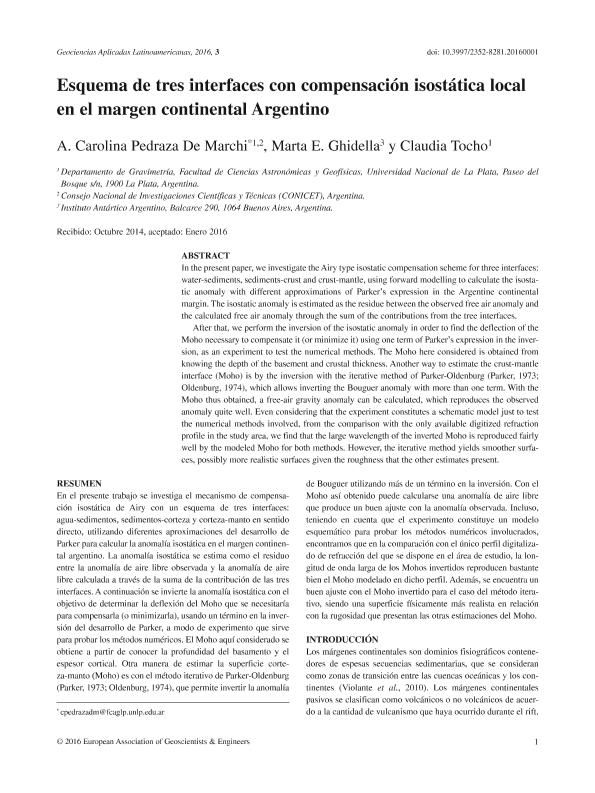Mostrar el registro sencillo del ítem
dc.contributor.author
Pedraza de Marchi, Ana Carolina

dc.contributor.author
Guidella, Marta
dc.contributor.author
Tocho, Claudia

dc.date.available
2020-08-31T15:35:59Z
dc.date.issued
2016-03
dc.identifier.citation
Pedraza de Marchi, Ana Carolina; Guidella, Marta; Tocho, Claudia; Esquema de tres interfaces con compensación isostática local en el margen continental Argentino; European Association of Geoscientists & Engineers; Geosciencias Aplicadas Latinoamericanas; 3; 1; 3-2016; 1-13
dc.identifier.issn
2352-8281
dc.identifier.uri
http://hdl.handle.net/11336/112766
dc.description.abstract
In the present paper, we investigate the Airy type isostatic compensation scheme for three interfaces:water-sediments, sediments-crust and crust-mantle, using forward modelling to calculate the isostaticanomaly with different approximations of Parkers expression in the Argentine continentalmargin. The isostatic anomaly is estimated as the residue between the observed free air anomaly andthe calculated free air anomaly through the sum of the contributions from the tree interfaces.After that, we perform the inversion of the isostatic anomaly in order to find the deflection of theMoho necessary to compensate it (or minimize it) using one term of Parkers expression in the inversion,as an experiment to test the numerical methods. The Moho here considered is obtained fromknowing the depth of the basement and crustal thickness. Another way to estimate the crust-mantleinterface (Moho) is by the inversion with the iterative method of Parker-Oldenburg (Parker, 1973;Oldenburg, 1974), which allows inverting the Bouguer anomaly with more than one term. With theMoho thus obtained, a free-air gravity anomaly can be calculated, which reproduces the observedanomaly quite well. Even considering that the experiment constitutes a schematic model just to testthe numerical methods involved, from the comparison with the only available digitized refractionprofile in the study area, we find that the large wavelength of the inverted Moho is reproduced fairlywell by the modeled Moho for both methods. However, the iterative method yields smoother surfaces,possibly more realistic surfaces given the roughness that the other estimates present.
dc.format
application/pdf
dc.language.iso
spa
dc.publisher
European Association of Geoscientists & Engineers

dc.rights
info:eu-repo/semantics/openAccess
dc.rights.uri
https://creativecommons.org/licenses/by-nc-sa/2.5/ar/
dc.subject
ISOSTASIA
dc.subject
ANOMALÍAS DE GRAVEDAD
dc.subject
MARGEN CONTINENTAL ARGENTINO
dc.subject
DESARROLLO DE PARKER
dc.subject.classification
Geoquímica y Geofísica

dc.subject.classification
Ciencias de la Tierra y relacionadas con el Medio Ambiente

dc.subject.classification
CIENCIAS NATURALES Y EXACTAS

dc.title
Esquema de tres interfaces con compensación isostática local en el margen continental Argentino
dc.type
info:eu-repo/semantics/article
dc.type
info:ar-repo/semantics/artículo
dc.type
info:eu-repo/semantics/publishedVersion
dc.date.updated
2020-08-19T20:19:44Z
dc.journal.volume
3
dc.journal.number
1
dc.journal.pagination
1-13
dc.journal.pais
Países Bajos

dc.description.fil
Fil: Pedraza de Marchi, Ana Carolina. Universidad Nacional de La Plata. Facultad de Ciencias Astronómicas y Geofísicas; Argentina. Consejo Nacional de Investigaciones Científicas y Técnicas. Centro Científico Tecnológico Conicet - La Plata; Argentina
dc.description.fil
Fil: Guidella, Marta. Ministerio de Relaciones Exteriores, Comercio Interno y Culto. Dirección Nacional del Antártico. Instituto Antártico Argentino; Argentina
dc.description.fil
Fil: Tocho, Claudia. Consejo Nacional de Investigaciones Científicas y Técnicas. Centro Científico Tecnológico Conicet - La Plata; Argentina. Universidad Nacional de La Plata. Facultad de Ciencias Astronómicas y Geofísicas; Argentina
dc.journal.title
Geosciencias Aplicadas Latinoamericanas
Archivos asociados
